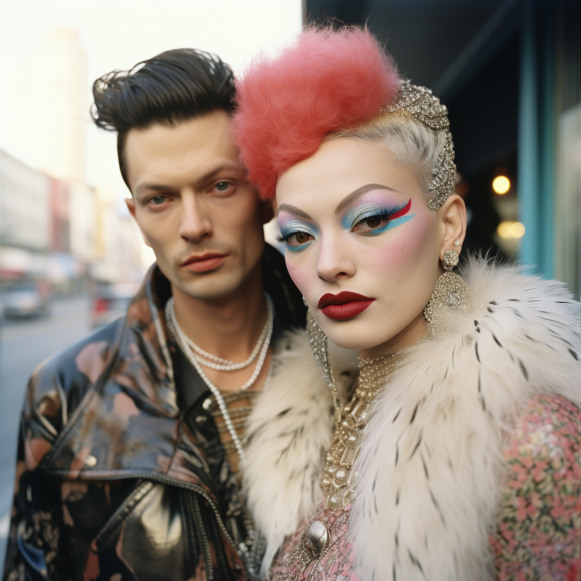San Francisco’s ‘last vibrant time’: Photographer captures city’s 1990s queer renaissance

Oakland photographer Chloe Sherman was part of San Francisco’s boundary-pushing cultural scene, which was largely centered in the Mission District before the dot-com boom
Oakland photographer Chloe Sherman’s new book of photographs immerses viewers in the last time San Francisco could claim to be an epicenter of American counterculture.
San Francisco was the epicenter of a queer cultural renaissance in the 1990s, centered primarily in the Mission District. Sherman was a part of this liberating, boundary-pushing social scene when she was in her twenties. She photographed her friends — stylish and spirited queer youth, punks, and artists — at clubs or around the neighborhood, at the beach, or in the intimacy of their apartments.
These images are now featured in the book “Renegades: San Francisco in the 1990s” (128 pages, Hatje Cantz). Sherman and her friends were drawn to San Francisco because of its natural beauty and history of welcoming outcasts — the beats in the 1950s, hippies in the 1960s, and gay men in the 1970s and 1980s. The city was also affordable enough for a new generation of young people to enjoy a community where they could experiment with life, art, fashion, sexuality, and gender just before the dot-com boom.
“It was such a pivotal time in San Francisco’s queer history,” Shermans told me in an interview.
During the Mission District’s gentrification, these “renegades” created a “ferociously sex-positive subculture” of “radical feminists, queer punks, and gender-variant people,” wrote Anna Joy Springer, an author and former vocalist for the punk rock band Blatz, in the book’s introduction.
There was also an explosion of female-owned clubs, cafes, bookstores, and other businesses during this time period, particularly along 14th Street. The Lexington Club dive bar, Red Dora’s Bearded Lady Cafe, Glama-Rama! Salon, and Black and Blue Tattoo all play prominent roles in Sherman’s book.
Sherman was raised in New York, Chicago, and Portland, Oregon. In her early twenties, she drove from Oregon to San Francisco for the first time with a friend.
“I was smitten by the city’s beauty, physicality, and everything else about it.” It had that gritty urban feel I was looking for.”
Sherman hoped to figure out how to pursue an art career while working as a bike messenger or at the nearby Real Food grocery store. She later received a BFA in photography from the San Francisco Art Institute. Meanwhile, she was paying $250 per month for her first apartment, a shared one in the Mission. Sherman described the affordability as “huge,” because it allowed people like her to work minimum-wage jobs while still having time to do art, socialize, and collaborate on projects.
It was also simple to meet new people at the time. People had to leave their homes in the pre-digital era to find entertainment and other diversions, and there was always something going on — a party, a show, or a gallery opening — most nights of the week, Sherman said. “You had to go out and get somewhere to find something,” she told me.
Sherman sought out young people her age and photographed them dancing in clubs, performing music, driving cool cars, getting tattoos, or lounging in the grass on lazy afternoon picnics. Her subjects are also dressed in era-appropriate attire, such as glamorous vintage gowns and classic suits and ties that represent the femme and butch aesthetics.”Seeing these images all at once is like being unexpectedly invited into the coolest (and tightest) group of friends you’ve ever had,” KQED arts and culture writer Rae Alexandra said.
Sherman and her friends were not only having fun, but they were also creating music, poetry, fiction, dance, and even experimental films. “It was a very inclusive environment for this generation to thrive,” Sherman went on to say. “You were surrounded by people who shared your interests. It was part of a very do-it-yourself approach. We just went with it and made it work. It was often done at night, but it was usually successful.”
Sherman compiled her photographs into a book after exhibiting them in a show at the Schlomer Haus Gallery near the Castro last year. She concluded her book with a photograph of her close friend Springer at her farewell party in 1999. By the end of the decade, Springer and others in Sherman’s circle had relocated to other cities, either for better job opportunities or because they were priced out of San Francisco. Sherman has since moved to Oakland for family reasons.
Dot-com Entrepreneurs may consider themselves to be part of a younger generation of San Francisco outlaws, but Sherman agrees that the enormous wealth they generated resulted in the hollowing out of a creative class that operates at the lower end of the economy.
“I feel really lucky to have been able to be there and to have chronicled that era,” said Sherman. “The city retains its beauty, and it remains a special place.” Having said that, the 1990s may have been the last of the most vibrant eras.”




